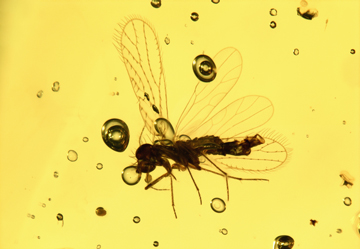Abstract
The genus Reissa Evenhuis & Báez in Greathead & Evenhuis (2001) was originally described based on a short series of extant specimens from the island of Tenerife in the Canary Islands. No further species of the genus have been discovered since. A related fossil genus (Riga Evenhuis) was described from Eocene Rovno amber (Evenhuis, 2013) and has some characters in common with the fossil specimen but differs in thoracic and antennal features. The new species described and illustrated here is represented by a single compression fossil of the new species Reissa kohlsi sp. nov. from the Parachute Creek member of the Green River Formation of Wyoming/Utah/Colorado, USA, the site of which dates from 51.2–48.7 my (Smith et al., 2008). It marks the first fossil record of the genus and its first record from the New World, and the first fossil record of the family Mythicomyiidae from North America. The family was previously known in the New World fossil record from the Miocene Dominican amber (cf. Evenhuis, 2013), including two representatives from the Mythicomyiinae (Mythicomyia dominicana Evenhuis, 2002 and Pieza dominicana Evenhuis, 2002).
References
Bezzi, M. (1924) The Bombyliidae of the Ethiopian Region. British Museum (Natural History), London, 390 pp.
Coquillett, D.W. (1893) An anomalous empid. Entomological News, 4, 208–210.
Cumming, J.M. & Wood, D.M. (2017) Adult morphology and terminology. In: Kirk-Spriggs, A.H. & Sinclair, B.J. (Eds), Manual of Afrotropical Diptera. Vol. 1. Introductory chapters and keys to Diptera. Suricata 4. South African National Biodiversity Institute, Pretoria, pp. 89–133.
Evenhuis, N.L. (1994) Catalogue of the fossil flies of the world (Insecta: Diptera). Backhuys Publishers, Leiden, 600 pp.
Evenhuis, N.L. (2002a) Pieza, a new genus of microbombyliids from the New World (Diptera: Mythicomyiidae). Zootaxa, 36, 1–28.
https://doi.org/10.11646/zootaxa.36.1.1
Evenhuis, N.L. (2002b) Catalog of the Mythicomyiidae of the world (Insecta: Diptera). Bishop Museum Bulletins in Entomology, 10, 1–85.
Evenhuis, N.L. (2013) New microbombyliids (Diptera: Mythicomyiidae) from Eocene Baltic and Rovno ambers, with notes on previously described amber species. Zootaxa, 3731 (3), 371–380.
https://doi.org/10.11646/zootaxa.3731.3.6
Gharali, B., Evenhuis, N.L. & Almeida, J. (2013) World synopsis of described species of the genus Platypygus Loew (Diptera: Mythicomyiidae: Platypyginae). Zootaxa, 3745 (2), 199–242.
https://doi.org/10.11646/zootaxa.3745.2.3
Greathead, D.J. (1993) Review of Dicranoclista Bezzi 1924 (Diptera: Bombyliidae): a zoogeographical enigma. Journal of African Zoology, 107, 467–473.
Greathead, D.J. & Evenhuis, N.L. (2001) Annotated keys to the genera of African Bombylioidea (Diptera: Bombyliidae; Mythicomyiidae). African Invertebrates, 42, 105–224.
https://doi.org/10.11646/zootaxa.3745.2.3
Grimaldi, D.A. (2016) Diverse orthorrhaphan flies (Insecta: Diptera: Brachycera) in amber from the Cretaceous of Myanmar: Brachycera in Cretaceous amber, Part VII. Bulletin of the American Museum of Natural History, 408 (1), 1–131.
https://doi.org/10.1206/0003-0090-408.1.1
Hall, J.C. & Evenhuis, N.L. (1986) Family Bombyliidae. In: Griffiths, G.C.D. (Ed.), Flies of the Nearctic Region. Vol. V. Part 13, no. 5. E. Schweizerbart, Stuttgart, pp. 321–592.
Hall, J.C. & Evenhuis, N.L. (1987) Family Bombyliidae. In: Griffiths, G.C.D. (Ed.), Flies of the Nearctic Region. Vol. V. Part 13, no. 5. E. Schweizerbart, Stuttgart, pp. 593–656.
Kalugina, N.S. & Kovalev, V.K. (1985) Dvukrylye nasekomye yuri Sibiri [Dipterous insects of Jurassic Siberia]. Paleontological Institute, Akademia Nauk, Moscow, 198 pp. [In Russian.]
Linnaeus, C. (1758) Systema naturae per regna tria naturae, secundum classes, ordines, genera, species, cum characteribus, differentiis, synonymis, locis. Tomus I. Editio decima, reformata. Laurentii Salvii, Holmiae [= Stockholm], [4] + 823 + [1 (Emendanda)] pp.
https://doi.org/10.5962/bhl.title.542
Macquart, P.J.M. (1840) Diptères exotiques nouveaux ou peu connus. Tome deuxième. 1re partie. Roret, Paris, pp. 5–135.
Melander, A.L. (1902) A monograph of the North American Empididae. Part I. Transactions of the American Entomological Society, 28, 195–367.
Melander, A.L. (1950) Taxonomic notes on some smaller Bombyliidae (Diptera) [part]. Pan-Pacific Entomologist, 26, 139–144.
Smith, M.E., Carroll, A.R. & Singer, B.S. (2009) Synoptic reconstruction of a major ancient lake system: Eocene Green River Formation, Western United States. Geological Society of America Bulletin, 120 (1/2), 54–84.
https://doi.org/10.1130/B26073.1
Spasojevic, T., Broad, G.R., Bennett, A.M.R. & Klopfstein, S. (2017) Ichneumonid parasitoid wasps from the Early Eocene Green River Formation: five new species and a revision of the known fauna (Hymenoptera, Ichneumonidae). PalZ, 92, 35–63.
https://doi.org/10.1007/s12542-017-0365-5
Wedmann, S. & Yeates, D.K. (2008) Eocene records of bee flies (Insecta, Diptera, Bombyliidae, Comptosia): their paleogeographic implications and remarks on the evolutionary history of bombyliids. Paleontology, 51 (1), 231–240.
https://doi.org/10.1111/j.1475-4983.2007.00745.x
Zaitzev, V.F. (1986) [New species of Cretaceous fossil bee flies and a review of paleontological data on Bombyliidae (Diptera)]. Entomologicheskoe Obozrenie, 65[1985], 815–825. [in Russian.]
Zhang, Q.Q., Zhang, J.F. & Wang, B. (2016) A remarkable brachyceran fly (Diptera: Tabanomorpha) from Late Cretaceous Burmese amber. Cretaceous Research, 67, 1–7.

